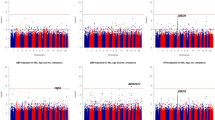Abstract
Hypertension is related to sodium intake, and many patients with essential hypertension are overweight and have the metabolic syndrome. We therefore studied microsatellite markers close to the thiazide-sensitive Na–Cl cotransporter on chromosome 16 and a quantitative trait locus for abdominal obesity-metabolic syndrome (AOMS2) on chromosome 17, which have been found to be linked to hypertension in a previous genome scan in Chinese. There were 84 hypertensive subjects (44 men, 40 women, age 53±13 years) and 88 normotensive controls (40 men, 48 women, age 54±13 years) recruited. Specific oligonucleotide primers were used to amplify genomic DNA spanning the microsatellite markers D16S3396 and D17S1303 that consist of ATA and GATA repeats, respectively. We did not find any association between D16S3396 and blood pressure. In contrast, the distribution of D17S1303 genotypes differed between hypertensive subjects and normal controls (P=0.014). The number of GATA repeats correlated inversely with diastolic blood pressure (r=−0.18, P=0.02) and body mass index (r=−0.12, P=0.01). Nine GATA repeats in D17S1303 were associated with hypertension (OR 2.19, 95% CI 1.08–4.44, P=0.027), while 14 GATA repeats were associated with normotension (OR 0.26, 95% CI 0.10–0.66, P=0.002). The diastolic blood pressure in those with or without the (GATA)9 allele was 85.9±13.6 and 79.2±13.6 mmHg respectively (P=0.01), and in those with or without the (GATA)14 allele it was 73.8±11.0 and 81.8±14.0 mmHg respectively (P=0.003). Our results provide further evidence that a gene predisposing to hypertension in Chinese is in the vicinity of the microsatellite D17S1303.
This is a preview of subscription content, access via your institution
Access options
Subscribe to this journal
Receive 12 digital issues and online access to articles
$119.00 per year
only $9.92 per issue
Buy this article
- Purchase on Springer Link
- Instant access to full article PDF
Prices may be subject to local taxes which are calculated during checkout


Similar content being viewed by others
References
Janus ED . Epidemiology of cardiovascular risk factors in Hong Kong. Clin Exp Pharmacol Physiol 1997; 24: 987–988.
Cheung BMY, Lam TC . Hypertension and diet. In: Caballero B, Trugo LC, Finglas PM (eds). Encyclopaedia of Food Sciences and Nutrition. Academic Press: London, 2003, pp 3194–3199.
Cheung BMY et al. The Hong Kong Cardiovascular Risk Factor Prevalence Survey cohort—results at 7 years. J Hypertens 2004; 22(Suppl 2): S268–S269.
Cheung BMY et al. The relationship between blood pressure and indices of obesity. Am J Hypertens 2002; 15: 188A.
Cheung BMY, Ho SPC, Lau CP . Diastolic blood pressure is related to sodium intake in hypertensive Chinese. Q J Med 2000; 93: 163–168.
Cheung BMY et al. The relationship between sodium and blood pressure in Hong Kong Chinese. Clin Res Regul Aff 2004; 21: 145–154.
Cheung BMY et al. Reducing sodium intake reduces ambulatory blood pressure in hypertensive patients. Am J Hypertens 2001; 14: 143A–144A.
Xu X et al. An extreme-sib-pair genome scan for genes regulating blood pressure. Am J Hum Genet 1999; 64: 1694–1701.
Simon DB et al. Gitelman's variant of Bartter's syndrome, inherited hypokalaemic alkalosis, is caused by mutations in the thiazide-sensitive Na–Cl cotransporter. Nat Genet 1996; 12: 24–30.
Kissebah AH et al. Quantitative trait loci on chromosomes 3 and 17 influence phenotypes of the metabolic syndrome. Proc Natl Acad Sci USA 2000; 97: 14478–14483.
Katsuya T et al. Association of angiotensinogen gene T235 variant with increased risk of coronary heart disease. Lancet 1995; 345: 1600–1603.
Khani-Hanjani A et al. Association between dinucleotide repeat in non-coding region of interferon-gamma gene and susceptibility to, and severity of, rheumatoid arthritis. Lancet 2000; 356: 820–825.
Reaven GM . Role of insulin resistance in human disease. Diabetes 1988; 37: 1595–1607.
Guerre-Millo M . Adipose tissue and adipokines: for better or worse. Diabetes Metab 2004; 30: 13–19.
Martin LJ et al. Bivariate linkage between acylation-stimulating protein and BMI and high-density lipoproteins. Obes Res 2004; 12: 669–678.
Rothenburg S, Koch-Nolte F, Haag F . DNA methylation and Z-DNA formation as mediators of quantitative differences in the expression of alleles. Immunol Rev 2001; 184: 286–298.
Matthew C . Postgenomic technologies: hunting the genes for common disorders. BMJ 2001; 322: 1031–1034.
Knight J, Munroe PB, Pembroke JC, Caulfield MJ . Human chromosome 17 in essential hypertension. Ann Hum Genet 2003; 67(Part 2): 193–206.
Gu F et al. Genetic susceptibility loci for essential hypertension and blood pressure on chromosome 17 in 147 Chinese pedigrees. J Hypertens 2004; 22: 1511–1518.
Tuomilehto J et al, Finnish Diabetes Prevention Study Group. Prevention of type 2 diabetes mellitus by changes in lifestyle among subjects with impaired glucose tolerance. N Engl J Med 2001; 344: 1343–1350.
Acknowledgements
This project was supported by a grant from the University of Hong Kong Committee for Research and Conference Grants.
Author information
Authors and Affiliations
Corresponding author
Rights and permissions
About this article
Cite this article
Cheung, B., Leung, R., Man, Y. et al. Association of essential hypertension with a microsatellite marker on chromosome 17. J Hum Hypertens 19, 407–411 (2005). https://doi.org/10.1038/sj.jhh.1001835
Received:
Revised:
Accepted:
Published:
Issue Date:
DOI: https://doi.org/10.1038/sj.jhh.1001835
Keywords
This article is cited by
-
Single-nucleotide polymorphisms near the microsatellite D17S1303 and the development of hypertension in a 6-year longitudinal study
Journal of Human Hypertension (2008)
-
Genome-wide Scan of Plasma Cholecystokinin in Baboons Shows Linkage to Human Chromosome 17*
Obesity (2007)
-
Hypertension and genes: perspectives from this journal
Journal of Human Hypertension (2007)
-
Association of hypertension with single nucleotide polymorphisms in the quantitative trait locus for abdominal obesity-metabolic syndrome on chromosome 17
Journal of Human Hypertension (2006)
-
Towards understanding the aetiology and pathophysiology of human hypertension: where are we now?
Journal of Human Hypertension (2006)



